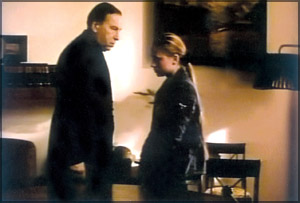
Uppalavanna: A portray of real human values
WIRUMA
Uppalavanna, a cinematic creation by Prof. Sunil Ariyarathne and
produced by Milina Sumathipala, for Sumathi Films now runs in the CEL
Circle.
FILM REVIEW: At the very outset the present film is not the story of
the much revered Uppalavanna Therani, the first among the Bhikkunis
during the times of Gauthama Buddha. The film does not resemble the
age-old story of that Therani. I am of the view that those who have seen
the film would agree with me and none would dispute it.
 The producer and the director really wanted to give a cinematic
creation of the life of the Therani, though difficult, an effort could
have been made to do so, to be fair by the audience flocking to view the
film with the thinking that the film is all about Uppalavanna, they have
read or heard in the dhamma deshana with reverence repeatedly. But it is
sad, the audience do not get the opportunity to see Uppalavanna, they
have heard, alive in the screen to satisfy their longing to see her as
the story unfolds. The producer and the director really wanted to give a cinematic
creation of the life of the Therani, though difficult, an effort could
have been made to do so, to be fair by the audience flocking to view the
film with the thinking that the film is all about Uppalavanna, they have
read or heard in the dhamma deshana with reverence repeatedly. But it is
sad, the audience do not get the opportunity to see Uppalavanna, they
have heard, alive in the screen to satisfy their longing to see her as
the story unfolds.
The story of Uppalavanna Maha Rahath Theraniya according to the
edited version of Gayan Chanuka Vidanapathirana is of a girl born a
daughter to a nobleman at Sawath Nuwara during the times the Gauthama
Buddha. She grew up to become an extra ordinarily beautiful young woman
and there were unprecedented numbers of proposals seeking her hand.
Her father found it difficult to consent to any of the proposals.
Fearing those whose proposals he refused would harm his daughter, he
suggests to the daughter to enter the Sasana. She willingly accepts the
advise of the father and enters the Sasana.
There was however one cousin, who had the desire to have her and at
an opportune time enters her abode hid himself under the bed she used to
rest. As she was relaxing, he jumped to the bed and seduced her. (Uppalavanna
Maha Rahath Theraniya - edited by Gayan Chanuka Vidanapathirana -1st
edition, August 2004 - A Dayawansa Jayakody and Company Publication).
In the 'Theri Gee' edited by Martin Wickremesinghe, the story is of
Upulwan Therani. It is a story where the Therani entered the Sasana
after realising that her own son had been her husband to both herself
and her daughter. (Theri Gee 1966 - edited by Martin Wickremesinghe, 3rd
edition - Mount Prakashakayo Publication).
According to some scholars the story of Upulwan Therani, was an
incident Uppalavanna Maha Rahath Theraniya was aware of, and was
conscious of it. The lay woman (Chandra Kaluarchchi) assisting the
Dasasil Mathas make passing reference to what happened to Uppalavanna
Therani. This reference makes it clear that the present story is
something different.
The film based on the script by Dr. Tissa Abeysekera has no relevance
to both stories mentioned above. In a subtle way the director of the
film say that the film is about a Therani of our times. But the fact is
that as there is no Meheni Sasana today, there are no Theranis in the
present day Buddha Sasana.
Hence the film is about a Dasasil Matha of our times. It deals with
the incidents of the 1989 youth revolt. Viewing the film as it unfolds,
the question that comes to our mind is, what was shown in the cinematic
form, is it acceptable to the Buddhist audience as the story rotates
around a Dasasil Matha, in religious garb? (played by Sangeetha
Weeraratne) Could she in her status help a dying man?
The tradition does not tolerate a Dasasil Matha seen seated side by
side with a Buddhist Monk sharing the same seat assigned for the
religious in public transport. When it is so, how could one tolerate a
Dasasil Matha serving a man in need, breathing his last?
The people gathering at the village temple express their resentment
and refuse to provide dana to the residence of the Dasasil Mathas,
because the monastery of the Dasasil Mathas gave protection or helped a
murderer.
One could argue saying that nothing is wrong in nursing a male in
need by a religious woman, as it is different from travelling in public
transport seated side by side.
That is exactly what the director of the film does, and he calls the
audience to think outside the box. This is why I posed the question
whether this is reckoned? Hence the film is to be admired for what it
offers to ponder. I take the liberty to say, the film is good in that
aspect although it has nothing to do with Uppalavanna or Upul Therani.
The film tries to portray the real human values, which are also Buddhist
values, one must cultivate and put to use whether it is meant for a
friend or a foe.
The mother of the murdered young man, (Chandani Seneviratne) who
comes to attack him listens to the admonition of the monk, she embrace
the dying youth, her son's murderer showing what it means to forgive,
love and to be compassionate to the enemy. That is love par excellence
'agape' because it is something very difficult for one to do, and she
does it and sends a message in action, to love the enemy even at the
most difficult time.
The issue I raise here is, why such a good story wanted to steal a
name of a Therani, while introducing the film as a contemporary Theri
gatha. Is it necessary to drag Uppalavanna Therani into this story?
While saying that it was a commendable effort on the part of director
to have drawn the audience to think loud with him reliving an incident
of our country's contemporary history and inviting the audience to think
differently, it is necessary to underline that the incident depicted has
no relevance to the life of Uppalavanna.
Hence to use the name of a Therani popular in the Buddhist world
could be said highly unethical. I am tempted to think both the producer
and the director (it is said the producer was keen to do a Buddhist
film) have used the piety of the ordinary Buddhist folk and marketed the
name for the obvious outcome in trading a name. I think the director
could have given a name appropriate to the present story.
The much-revered name of Uppalavanna Therani is used as a means to
draw the crowd and the special screening of the film, to a group of
Buddhist Monks to get their comments, as credence to the film-going
public eager to see a Buddhist film.
I am of the view that there are no religious films as such, although
films are made basing sacred characters. By the way do the rules and
regulations to be observed by the disciples of the Gauthama Buddha allow
viewing films, attending theatre halls to view dramas?
Of course with all that, one must appreciate the film for brining a
very valid socio-religious question and inviting the audience to think
deep about their piety, to examine, to see how rigid and illogical they
have been, with their misunderstanding or misinterpretation of religious
piety and their outlook towards those in religious garb.
As we watch the film the question that arises in our mind is, what is
wrong for a woman in religious garb (within the Buddhist clergy) in
helping a dying man? Should the robe be an obstacle in helping a man in
utter despair and dying?
While from a secular and human point of view there is nothing wrong
in helping a fellow being and consenting that one's religious garb
should not be a hindrance to do what is necessary when situations
demand, an outsider need not raise eye-brows having seen a religious
woman helping a wounded man. After all we cannot sit on the judgment
over one's beliefs and convictions.
It is a question one in religious garb should answer. It is also up
to the one in religious attire to do things setting good examples for
others to follow and live up to the life chosen voluntarily with
commitment and dedication as the father (Suminda Sirisena) of the
Dasasil Matha says to liberate the entire clan (Hathara varigayama
sasarin ethera karanna).
This faithfulness to one's chosen life is equally applied to the
married couples in this instance to women, for after all they are women.
The castigation by the Buddhist monk at a close-by temple to the
monastery, give a mouthful over the wrong attitude of the Buddhist lay
folk who refuse to entertain the Dasasil Mathas because one of them has
helped a criminal, a terrorist although he was a man terribly wounded,
dying and needed to be looked after and treated as a fellowman.
That utterance set the stage for the right thinking people to act
with conviction and courage. It also gives meaning to Meththa, Karuna,
Muditha and Upekha that people should cultivate as fellow beings of the
society they live.
The concept of the story is thought-provoking. It calls the pious
Buddhist to re-think and understand the deep meaning of religious piety
and of values and discards their false belief. Whether one is a
religious or married one could falter if one is not faithful to the
promise taken. The director also brings the early-married life of this
Dasasil Matha.
She, a product of the aristocratic family, marries a son of a tom-tom
beater, who is a dancing master. Parents hate this marriage and the
mother of the girl dies. When the couple comes to pay their last
respects to the dead mother, father shoots the boy.
His shooting manifest the deep resentment, intolerance and inability
to accept his son-in-law, despite his learning that the man is a noble
being through his good acts and not by his birth. With the death of her
husband the girl enters the Aranya to become a Dasasil Matha under the
tutelage of the Chief Dasasil Matha (Malini Fonseka).
To be fair by both the producer and the director of the film I must
say although it is not the story of Uppalavanna Therani one like to
watch in the silver screen, it is a good and timely story in itself
though cumbersome to watch at times.
There is nothing to rouse the feelings, fails to enthrall or move the
audience to action. If not for the role played by Sandali as the young
Silmatha and Chandra Kaluarachchi as the helper at the Aranya, there was
no life in the film.
Hollywood eyes $4 billion summer box office record
  Hollywood movie studios on Monday eyed a $4 billion summer record at
U.S. and Canadian box offices after this weekend's strong opening for
teen sex comedy "Superbad" and other recent films that topped forecasts.
"Superbad" opened at No. 1 with final domestic ticket sales of $33
million, up about 6 percent from Sunday's estimated $31.2 million. Hollywood movie studios on Monday eyed a $4 billion summer record at
U.S. and Canadian box offices after this weekend's strong opening for
teen sex comedy "Superbad" and other recent films that topped forecasts.
"Superbad" opened at No. 1 with final domestic ticket sales of $33
million, up about 6 percent from Sunday's estimated $31.2 million.
Since late June, thriller "Transformers," animated comedy "The
Simpsons Movie," musical "Hairspray" and animated "Ratatouille" all have
beat expectations.
The summer season, which runs from early May through August and has
two weeks remaining, is Hollywood's most lucrative period during which
the studios can produce up to 40 percent of their annual revenues.
"We will certainly surpass $4 billion and probably be around $4.1
billion. I also think we will be at 600 million tickets sold, which we
haven't seen in a few years," said Paul Dergarabedian, head of ticket
sales tracker Media By Numbers. So far, domestic ticket sales stand at
around $3.83 billion, up some 10 percent from last year and 5 percent
ahead of the pace for 2004's record summer of $3.95 billion.
Admissions are 559 million, up 5 percent from last year, according to
Media By Numbers. Internationally, box offices have been strong too. But
overseas figures are not compiled as quickly for various films opening
in different countries on different dates. Summer 2007 hits included
May's so-called "three-quels," "Spider-Man 3," "Shrek the Third" and
"Pirates of the Caribbean: At World's End." Like "Transformers," they
all grossed more than $300 million in domestic ticket sales. Action
adventures "Live Free or Die Hard" and "Harry Potter and the Order of
the Phoenix" performed roughly as expected, while comedy "Knocked Up"
and supernatural thriller "1408" were among surprise successes.
The biggest financial loser likely will be "Evan Almighty." The
comedy has taken in nearly $100 million at domestic box offices and
slightly more than $31 million overseas. But it cost $175 million to
make and tens of millions more to market.
Troubled actress Lindsay Lohan proved to be a summer misfire,
starring in "Georgia Rule" and "I Know Who Killed Me" that both flopped
at box offices. Other misses included "Nancy Drew," "Hostel: Part II"
and "A Mighty Heart."
(Reuters)
Await the Poland
film festival
 A series of Polish films will be shown to the public free to
celebrate 50 years of diplomatic relations between Sri Lanka and Poland.
The following films will be shown at the Elphinstone theatre on August
29 and 30 at 3.30 p.m. and 6.30 p.m. A series of Polish films will be shown to the public free to
celebrate 50 years of diplomatic relations between Sri Lanka and Poland.
The following films will be shown at the Elphinstone theatre on August
29 and 30 at 3.30 p.m. and 6.30 p.m.
August 29
'In the desert and the wilderness' (Children's film) - 3.30 p.m.
Director: Gavin Hood (2001)
The film, based on a novel by Polish Nobel Prize winner Henryk
Sinekiewicz (1905), tells the story of two children - a 14-year-old
Polish boy Star Tarkowski and an eight-year-old English girl Nel
Rawilson raped by an Arabian leader Mahdi during their staying with
their fathers - engineers working in construction work of the Suez Canal
in Africa.
The fathers organise the chase but it proves extremely difficult due
to the war conditions on the continent. The children, abandoned to their
own fate, wander across the wild Africa with their black friend - Kali
and Mea.
'The Orchestra Conductor'
- 6.30 p.m.
Director: Andrzej Wajda (1980)
 What really attracted Wajda about orchestra was its quality for a
social organism in miniature, ideally suited to convey all sorts of
metaphors pertaining to society, its organisation, and human
inter-relations in general. It is Poland that he has portrayed in the
guise of the orchestra. What really attracted Wajda about orchestra was its quality for a
social organism in miniature, ideally suited to convey all sorts of
metaphors pertaining to society, its organisation, and human
inter-relations in general. It is Poland that he has portrayed in the
guise of the orchestra.
In 1980, in the year of Conductor's premiere, Ingmar Bergman - the
world cinema personality - wrote to Wajda: "Dear friend, we have just
seen your masterpiece, 'The Orchestra Conductor' and we can not wait to
tell you how grateful, deeply moved and happy we all are."
August 30
(Children's film) - 3.30 p.m.
'Love stories' - 6.30 p.m.
Director: Jerzy Stuhr
Four stories of love: yearned-for, betrayed, found. In the
confessional, a priest is confronted for the first time by his
eleven-year-old daughter (and seeks advice from his mother); a married
colonel in the Polish Army is reunited with an old lover; a convict is
jilted by his wife but has the last word; a professor of literature must
decide how to react to a lacklustre student who declares she is in love
with him.
Sometimes things go wrong, occasionally right. (The colonel flushes
love letters down a toilet, rather than burn them.) In each vignette,
the protagonist is played by Jerzy Stuhr, who also wrote and directed
this film.
The event is organised by the Consul-General of Poland in Sri Lanka,
the embassy of Poland in India, Sri Lankan-Poland Business Council and
Winston Films. |

